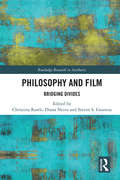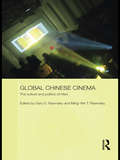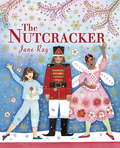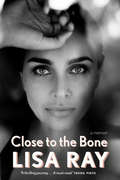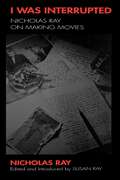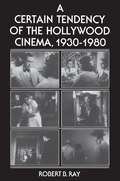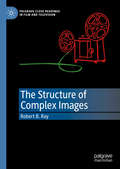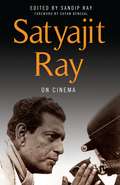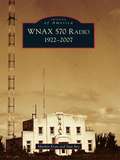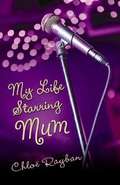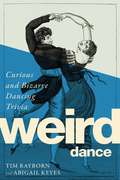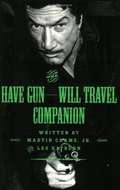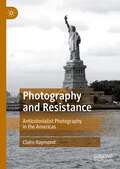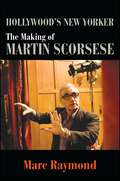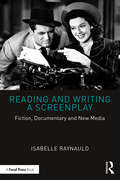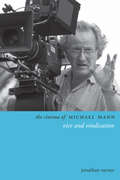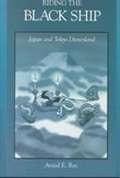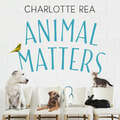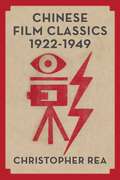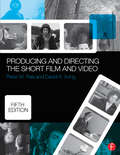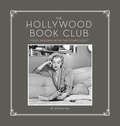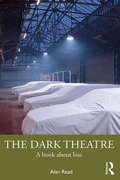- Table View
- List View
Philosophy and Film: Bridging Divides (Routledge Research in Aesthetics)
by Christina Rawls Diana Neiva Steven S. GouveiaThis volume collects twenty original essays on the philosophy of film. It uniquely brings together scholars working across a range of philosophical traditions and academic disciplines to broaden and advance debates on film and philosophy. The book includes contributions from a number of prominent philosophers of film including Noël Carroll, Chris Falzon, Deborah Knight, Paisley Livingston, Robert Sinnerbrink, Malcolm Turvey, and Thomas Wartenberg. While the topics explored by the contributors are diverse, there are a number of thematic threads that connect them. Overall, the book seeks to bridge analytic and continental approaches to philosophy of film in fruitful ways. Moving to the individual essays, the first two sections offer novel takes on the philosophical value and the nature of film. The next section focuses on the film-as-philosophy debate. Section IV covers cinematic experience, while Section V includes interpretations of individual films that touch on questions of artificial intelligence, race and film, and cinema’s biopolitical potential. Finally, the last section proposes new avenues for future research on the moving image beyond film. This book will appeal to a broad range of scholars working in film studies, theory, and philosophy.
Global Chinese Cinema: The Culture and Politics of 'Hero' (Media, Culture and Social Change in Asia)
by Gary D. RawnsleyThe film Hero, directed by Zhang Yimou and released in 2002, is widely regarded as the first globally successful indigenous Chinese blockbuster. A big expensive film with multiple stars, spectacular scenery, and astonishing action sequences, it touched on key questions of Chinese culture, nation and politics, and was both a domestic sensation and an international hit. This book explores the reasons for the film’s popularity with its audiences, discussing the factors which so resonated with those who watched the film. It examines questions such as Chinese national unity, the search for cultural identity and role models from China’s illustrious pre-communist past, and the portrayal of political and aesthetic values, and attitudes to gender, sex, love, and violence which are relatively new to China. The book demonstrates how the film, and China’s growing film industry more generally, have in fact very strong international connections, with Western as well as Chinese financing, stars recruited from the East Asian region more widely, and extensive interactions between Hollywood and Asian artists and technicians. Overall, the book provides fascinating insights into recent developments in Chinese society, popular culture and cultural production.
The Nutcracker
by Jane RayThe ultimate children's gift edition of the beloved classic ballet story, The Nutcracker.Christmas Eve is the most magical night of the year, when the house is scented with wood smoke and spices, and there are secrets under every bed . . . When the clock strikes midnight, Clara's new nutcracker doll comes to life and leads her on a thrilling adventure, battling with the wicked Mouse King and his troops, then journeying to the Kingdom of Sweets. Retold simply and lyrically, with enchanting illustrations that capture all the joy and excitement of Christmas, this beautiful book from award-winning book-maker Jane Ray, this is the ultimate contemporary edition of everyone's favourite Christmas ballet story!
Close to the Bone: A Memoir
by Lisa Ray&“A thrilling journey. . . . A must-read.&” Freida Pinto &“How fortunate a thing it is, when life alters you without warning.&” Lisa Ray is one of India&’s first supermodels. She&’s also an acclaimed actor, a cancer survivor, a mother of twins born through surrogacy, a lifelong student, and a person of no fixed address. She is a woman who has lived many lives. And this is her story.Unflinching and deeply moving, Close to the Bone traces Lisa Ray&’s serendipitous life, from her childhood in Canada as the biracial daughter of an Indian man and Polish woman, to her rise as a Bollywood star; from her battle with a rare and incurable cancer, to her journey to find identity and belonging, both in the world and in her own body. Transporting and atmospheric, it takes readers across the globe: Toronto in the 1970s, when Lisa was searching for place and purpose; the intense, frenetic streets of Bombay, where, young and unmoored, she became a peer of some of the biggest names in the Bollywood industry; the lush sensuality of Colombo and a film role that changed the course of her career; and in London, where she simultaneously found her footing in drama school and lost herself in an abusive relationship. It is a storied life, and one whose adventures teach Lisa that in the brightest and darkest moments, no matter where she travels to, she can always find her way back home—to herself. At once charming and wise, intimate and gut-wrenchingly honest, Close to the Bone is a revealing travelogue of the soul—a brave and inspiring story of a life lived on one&’s own terms.
I Was Interrupted: Nicholas Ray on Making Movies
by Nicholas RayOne of the most original, rebellious, and idiosyncratic directors in the American cinema, Nicholas Ray lived and worked with an intensity equal to that of his films. Best known for his direction of James Dean in Rebel Without a Cause (1955), he is also well regarded for his cult western Johnny Guitar (1954), and such prestigious noir classics as On Dangerous Ground (1951). I Was Interrupted offers a provocative selection of the filmmaker's writings, lectures, interviews, and more.
A Certain Tendency of the Hollywood Cinema, 1930-1980
by Robert B. RayRobert B. Ray examines the ideology of the most enduringly popular cinema in the world--the Hollywood movie. Aided by 364 frame enlargements, he describes the development of that historically overdetermined form, giving close readings of five typical instances: Casablanca, It's a Wonderful Life, The Man Who Shot Liberty Valance, The Godfather, and Taxi Driver. Like the heroes of these movies, American filmmaking has avoided commitment, in both plot and technique. Instead of choosing left or right, avant-garde or tradition, American cinema tries to have it both ways.Although Hollywood's commercial success has led the world audience to equate the American cinema with film itself, Hollywood filmmaking is a particular strategy designed to respond to specific historical situations. As an art restricted in theoretical scope but rich in individual variations, the American cinema poses the most interesting question of popular culture: Do dissident forms have any chance of remaining free of a mass medium seeking to co-opt them?
The Structure of Complex Images (Palgrave Close Readings in Film and Television)
by Robert B. RayAfter over a century of existence, the cinema still has its mysteries. Why, for example, is the job we call movie stardom unlike any other in the world? How do films provide so much unconcealed information that we fail to notice? What makes it hard to define what counts as “acting”? How do movies like Casablanca and Breathless store the film and world histories of their generations? How can we reconcile auteurism’s celebration of the movie director’s authority with the camera’s automatism? Why have the last four decades of film criticism so often neglected such questions? After beginning with an overview of film studies, this book proposes a shift from predictable theoretical approaches to models that acknowledge the perplexities and mysteries of the movies. Deriving methods from cinephilia, Wittgenstein, Richard Rorty, Stanley Cavell, Eleanor Duckworth, V. F. Perkins, and James Naremore, Robert B. Ray offers close readings that call attention to what we have missed in such classic films as La Règle du Jeu, It Happened One Night, It’s a Wonderful Life, Vertigo, Holiday, The Philadelphia Story, Casablanca, Breathless, and Tickets.
Satyajit Ray on Cinema
by Satyajit RaySatyajit Ray, one of the greatest auteurs of twentieth century cinema, was a Bengali motion-picture director, writer, and illustrator who set a new standard for Indian cinema with his Apu Trilogy: Pather Panchali (Song of the Little Road) (1955), Aparajito (The Unvanquished) (1956), and Apur Sansar (The World of Apu) (1959). His work was admired for its humanism, versatility, attention to detail, and skilled use of music. He was also widely praised for his critical and intellectual writings, which mirror his filmmaking in their precision and wide-ranging grasp of history, culture, and aesthetics. Spanning forty years of Ray's career, these essays, for the first time collected in one volume, present the filmmaker's reflections on the art and craft of the cinematic medium and include his thoughts on sentimentalism, mass culture, silent films, the influence of the French New Wave, and the experience of being a successful director. Ray speaks on the difficulty of adapting literary works to screen, the nature of the modern film festival, and the phenomenal contributions of Jean-Luc Godard and the Indian actor, director, producer, and singer Uttam Kumar. The collection also features an excerpt from Ray's diaries and reproduces his sketches of famous film personalities, such as Sergei Eisenstein, Charlie Chaplin, and Akira Kurosawa, in addition to film posters, photographs by and of the artist, film stills, and a filmography. Altogether, the volume relays the full extent of Ray's engagement with film and offers extensive access to the thought of one of the twentieth-century's leading Indian intellectuals.
WNAX 570 Radio: 1922-2007
by Stan Ray Marilyn KratzLife on the northern plains was lonely in the early 20th century. Farmers and ranchers went for weeks without hearing any voices other than those of their families. Then, in 1922, Al Madson, proprietor of a Yankton radio parts shop, made a radio transmitter. He formed a broadcasting company, and on November 25, 1922, WNAX broadcast its first program. People of the northern plains now had a daily "visitor." Gurney Seed and Nursery Company owned the station for its first 16 years, adding distinctive innovations to its programming. In its constant commitment to agriculture, the station has influenced the history of the five-state area it covers. Lawrence Welk got his start there. Wynn Speece, known as the Neighbor Lady, still broadcasts daily after starting at WNAX in 1941.
My Life Starring Mum
by Chloë RaybanHollywood Bliss Winterman leads a fairly uneventful life at the Convent of the Sisters of the Resurrection boarding school. But everything changes when her mega-famous, rock star mother Khandi yanks Holly out of boarding school, plunks her into a private, secure suite at a posh hotel in London, and promptly forgets that her daughter is even there. With only a mobile phone and pet rabbit to keep her company, Holly's diary of her life (starring her mum) will resonate with any teenage girl who's ever been embarrassed by her mother.
Weird Dance: Curious and Captivating Dance Trivia
by Tim Rayborn Abigail KeyesAttend a grand ball of the bizarre and never look at dance the same way again!Weird Dance processes through the odd, grim, and unintentionally humorous history of dance, uncovering strange stories and weird facts.These dark tales of murder, rivalry, insanity, and more reveal all sorts of grim goings-on, proving that—for dancers—life was not just one grand plié. Stories include: An elderly woman who stepped out of her Strasbourg home one summer day in 1518 and began to dance furiously; nothing and no one could stop her. Soon, dozens more joined her, and so began another strange epidemic of the deadly dancing plague. The horrific fate of a young ballerina who had a run-in with a gaslight and saw her career go up in smoke. The medieval Dance of Death that reminded all of their inevitable doom. The controversial ballet that sparked a riot. The strange and macabre fate of the infamous Mata Hari’s head after her execution. The grotesque scarf accident that led to Isadora Duncan’s demise.From Roman Bacchanals to medieval and Renaissance dancing plagues, from the bloody world of ballet to scandals, ghosts, spirit possessions, superstitions, and more, you will attend a grand ball of the bizarre that shows just how awful dancers, choreographers, and even audience members have been to each other over the centuries.
The Have Gun, Will Travel Companion
by Les Rayburn Martin GramsThis program ran for six seasons--225 episodes--and this book tells all about its planning, its presenting, its struggles, and its people. If just reading the title makes you start humming the theme song, you won't want to miss a word!
Photography and Resistance: Anticolonialist Photography in the Americas
by Claire RaymondThis book argues that photography, with its inherent connection to the embodied material world and its ease of transmissibility, operates as an implicitly political medium. It makes the case that the right to see is fundamental to the right to be. Limning the paradoxical links between photography as a medium and the conditions of political, social, and epistemological disappearance, the book interprets works by African American, Indigenous American, Latinx, and Asian American photographers as acts of political activism in the contemporary idiom. Placing photographic praxis at the crux of 21st-century crises of political equity and sociality, the book uncovers the discursive visual movements through which photography enacts reappearances, bringing to visibility erased and elided histories in the Americas. Artists discussed in-depth include Shelley Niro, Carrie Mae Weems, Paula Luttringer, LaToya Ruby Frazier, Matika Wilbur, Martine Gutiérrez, Ana Mendieta, An-My Lê, and Rebecca Belmore. The book makes visible the American land as a site of contestation, an as-yet not fully recognized battlefield.
Hollywood's New Yorker: The Making of Martin Scorsese (SUNY series, Horizons of Cinema)
by Marc RaymondWhen Martin Scorsese finally won an Academy Award in 2007, for The Departed, it was widely viewed as the crowning achievement of a remarkable film career. But what it also represented was an acceptance by Hollywood of a man who became a prestigious auteur precisely because of his status as an outsider from New York. For someone with a high-culture reputation like Scorsese's, this middlebrow sign of respectability was not about cultural standing; rather, it was about using and even sacrificing his distinctive outsider status for a greater share of industry authority within the world of Hollywood.In Hollywood's New Yorker, Marc Raymond offers a fresh look at Scorsese's career in relation to the critical and social environment of the past fifty years. He traces Scorsese's career and films through his association with various cultural institutions, from his role as a student and instructor at New York University, to his move to Hollywood and his relationship with the studio system, to his relationship with prestigious institutions like the Museum of Modern Art. This sociological approach to film authorship provides analysis of previously overlooked Scorsese projects, particularly his documentary work, and gives importance to the role his extracurricular activities in the film preservation movement have played in the rise of his reputation.Hollywood's New Yorker places Scorsese and his films firmly within the various time periods of his career and compares the director with his peers, from fellow New Yorkers like Brian De Palma and Woody Allen to New Hollywood movie brats such as Francis Ford Coppola and Steven Spielberg. The result is a complete picture of Scorsese and the post–World War II American film culture he has both shaped and been shaped by.
Reading and Writing a Screenplay: Fiction, Documentary and New Media
by Isabelle RaynauldReading and Writing a Screenplay takes you on a journey through the many possible ways of writing, reading and imagining fiction and documentary projects for cinema, television and new media. It explores the critical role of a script as a document to be written and read with both future readers and the future film it will be giving life to in mind. The book explores the screenplay and the screenwriting process by approaching the film script in three different ways: how it is written, how it is read and how it can be rewritten. Combining contemporary screenwriting practices with historical and academic context, Isabelle Raynauld provides key analytical tools and reading strategies for conceptualizing and scripting projects based on the impact different writing styles can have on readers, with various examples ranging from early cinema to new media and new platforms throughout. This title offers an alternative, thought-provoking and inspiring approach to reading and writing a screenplay that is ideal for directors, producers, actors, students, aspiring screenwriters and readers interested in understanding how an effective screenplay is created.
The Cinema of Michael Mann: Vice and Vindication (Directors' Cuts)
by Jonathan RaynerMichael Mann is one of the most important American filmmakers of the past forty years. His films exhibit the existential concerns of art cinema, articulated through a conspicuous and recognizable visual style and yet integrated within classical Hollywood narrative and genre frameworks. Since his beginnings as a screenwriter in the 1970s, Mann has become a key figure within contemporary American popular culture as writer, director, and producer for film and television. This volume offers a detailed study of Mann's feature films, from The Jericho Mile (1979) to Public Enemies (2009), with consideration also being given to parallels in the production, style, and characterization in his television work. It explores Mann's relationship with classical genres, his thematic concentration on issues of morality and masculinity, his film adaptations from literature, and the development and significance of his trademark visual style within modern American cinema.
The Cinema of Michael Mann
by Jonathan RaynerMichael Mann is one of the most important American filmmakers of the past forty years. His films exhibit the existential concerns of art cinema, articulated through a conspicuous and recognizable visual style and yet integrated within classical Hollywood narrative and genre frameworks. Since his beginnings as a screenwriter in the 1970s, Mann has become a key figure within contemporary American popular culture as writer, director, and producer for film and television. This volume offers a detailed study of Mann's feature films, from The Jericho Mile (1979) to Public Enemies (2009), with consideration also being given to parallels in the production, style, and characterization in his television work. It explores Mann's relationship with classical genres, his thematic concentration on issues of morality and masculinity, his film adaptations from literature, and the development and significance of his trademark visual style within modern American cinema.
Garth Pig Steals the Show
by Mary RaynerFrom the book: The Pig family has formed a band, but they need one more player. On the very day of their big concert, a hairy horn-blower sticks her long, pointed nose through the door and volunteers to play. William Pig wonders about this mysterious musician who spends most of the performance licking her lips. And when Garth suddenly disappears from his chair, it's up to William to save his little brother and the show. With some creative conducting, he brings the concert to an unforgettable finale. Performing with all the humor and affection of their previous adventures, Mary Rayner's beloved Pig family is sure to receive a hearty "Bravo!" for their latest triumph. Other books about the Pig family are available from Bookshare.
Sophocles' Antigone
by Diane J. RayorSophocles' Antigone comes alive in this new translation that will be useful for academic study and stage production. Diane Rayor's accurate yet accessible translation reflects the play's inherent theatricality. She provides an analytical introduction and comprehensive notes, and the edition includes an essay by director Karen Libman. Antigone begins after Oedipus and Jocasta's sons have killed each other in battle over the kingship. The new king, Kreon, decrees that the brother who attacked with a foreign army remain unburied and promises death to anyone who defies him. The play centers on Antigone's refusal to obey Kreon's law and Kreon's refusal to allow her brother's burial. Each acts on principle colored by gender, personality and family history. Antigone poses a conflict between passionate characters whose extreme stances leave no room for compromise. The highly charged struggle between the individual and the state has powerful implications for ethical and political situations today.
Riding the Black Ship: Japan and Tokyo Disneyland
by Aviad E. RazIn 1996 over 16 million people visited Tokyo Disneyland, making it the most popular of the many theme parks in Japan. Since it opened in 1983, Tokyo Disneyland has been analyzed mainly as an example of the globalization of the American leisure industry and its organizational culture, particularly the "company manual." By looking at how Tokyo Disneyland is experienced by employees, management, and visitors, Aviad Raz shows that it is much more an example of successful importation, adaptation, and domestication and that it has succeeded precisely because it has become Japanese even while marketing itself as foreign. Rather than being an agent of Americanization, Tokyo Disneyland is a simulated "America" showcased by and for the Japanese. It is an "America" with a Japanese meaning.
Animal Matters: Diary of an Inner City Vet
by Charlotte ReaAnimals bond people and transcend class, financial and cultural barriers, pets matter to people more than anything, but what happens to those people who can't afford pet insurance or vet's bills.Animal Matters is a diary of real-life cases written during a year of Charlotte's career working as a veterinary surgeon in a 24-hour inner-city London animal charity hospital. The book provides readers with a revealing, honest, emotional experience, with deeply sad moments followed by amusing and unimaginable ones. Charlotte writes both short amusing diary entries along with more detailed accounts and reflections back on her training and the experiences and difficulties she has come up against over the decade since she graduated. Throughout the book you will get to know both the animals and the people and how close the bond between us can be. Charlotte also discusses contemporary issues in veterinary medicine such as animal euthanasia, RSPCA welfare cases, mental health issues within the veterinary profession, ethical concerns around pedigree dog breeding and the laws on dangerous dogs. Animal Matters is a moving and heartwarming book about the unconditional love between animals and humans, and how deep the bond can be.(P)2019 Hodder & Stoughton Limited
Chinese Film Classics, 1922–1949
by Christopher G. ReaChinese Film Classics, 1922–1949 is an essential guide to the first golden age of Chinese cinema. Offering detailed introductions to fourteen films, this study highlights the creative achievements of Chinese filmmakers in the decades leading up to 1949, when the Communists won the civil war and began nationalizing cultural industries.Christopher Rea reveals the uniqueness and complexity of Republican China’s cinematic masterworks, from the comedies and melodramas of the silent era to the talkies and musicals of the 1930s and 1940s. Each chapter appraises the artistry of a single film, highlighting its outstanding formal elements, from cinematography to editing to sound design. Examples include the slapstick gags of Laborer’s Love (1922), Ruan Lingyu’s star turn in Goddess (1934), Zhou Xuan’s mesmerizing performance in Street Angels (1937), Eileen Chang’s urbane comedy of manners Long Live the Missus! (1947), the wartime epic Spring River Flows East (1947), and Fei Mu’s acclaimed work of cinematic lyricism, Spring in a Small Town (1948). Rea shares new insights and archival discoveries about famous films, while explaining their significance in relation to politics, society, and global cinema. Lavishly illustrated and featuring extensive guides to further viewings and readings, Chinese Film Classics, 1922–1949 offers an accessible tour of China’s early contributions to the cinematic arts.
Producing and Directing the Short Film and Video
by Peter Rea David K. IrvingProducing and Directing the Short Film and Video, Fifth Edition is the definitive book on the subject for the serious film student or beginning filmmaker. Its unique two-fold approach looks at filmmaking from the perspectives of both the producer and director, and clearly explains how their separate roles must work together to create a successful short film or video. Through extensive examples from award-winning shorts and insightful interviews, you will learn about common challenges the filmmakers encountered during each step of filmmaking process—from preproduction to production, postproduction, and distribution—and the techniques they used to overcome them. In celebrating this book’s twentieth anniversary, this edition has been updated to include: Two all-new, in-depth cases studies of esteemed short films—Memory Lane and the Academy Award-winning God of Love A revised chapter progression that reinforces the significance of the actor - director relationship Interviews with the filmmakers integrated alongside the text, as well as new images and behind-the-scenes coverage of production processes Revamped sections on current financing strategies, postproduction workflows, and the wide variety of distribution platforms now available to filmmakers A "Where are They Now" appendix featuring updates on the original filmmakers covered in the first edition An expanded companion website (www.focalpress.com/cw/rea) containing useful forms and information on distributors, grants and financing sources, film and video festivals, film schools, internet sources for short works, and professional associations
The Hollywood Book Club
by Steven ReaAudrey Hepburn, Humphrey Bogart, Gregory Peck, Rita Hayworth, Marilyn Monroe—the brightest stars of the silver screen couldn't resist curling up with a good book. This unique collection of rare photographs celebrates the joy of reading in classic film style. The Hollywood Book Club captures screen luminaries on set, in films, in playful promotional photos, or in their own homes and libraries with books from literary classics to thrillers, from biographies to children's books, reading with their kids, and more. Featuring nearly 60 enchanting images, lively captions about the stars and what they're reading by Hollywood photo archivist Steven Rea, here's a real page-turner for booklovers and cinephiles.
The Dark Theatre: A Book About Loss
by Alan ReadThe Dark Theatre is an indispensable text for activist communities wondering what theatre might have to do with their futures, students and scholars across Theatre and Performance Studies, Urban Studies, Cultural Studies, Political Economy and Social Ecology. The Dark Theatre returns to the bankrupted warehouse in Hope (Sufferance) Wharf in London’s Docklands where Alan Read worked through the 1980s to identify a four-decade interregnum of ‘cultural cruelty’ wreaked by financialisation, austerity and communicative capitalism. Between the OPEC Oil Embargo and the first screening of The Family in 1974, to the United Nations report on UK poverty and the fire at Grenfell Tower in 2017, this volume becomes a book about loss. In the harsh light of such loss is there an alternative to the market that profits from peddling ‘well-being’ and pushes prescriptions for ‘self-help’, any role for the arts that is not an apologia for injustice? What if culture were not the solution but the problem when it comes to the mitigation of grief? Creativity not the remedy but the symptom of a structural malaise called inequality? Read suggests performance is no longer a political panacea for the precarious subject but a loss adjustor measuring damages suffered, compensations due, wrongs that demand to be put right. These field notes from a fire sale are a call for angry arts of advocacy representing those abandoned as the detritus of cultural authority, second-order victims whose crime is to have appealed for help from those looking on, audiences of sorts.
